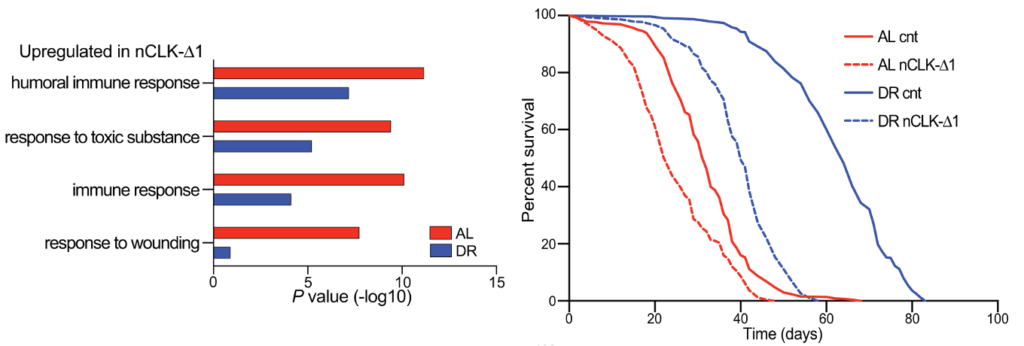Regular Sleep-Wake Cycle Essential for Prolonged Lifespan via Dietary Restriction
Buck Institute scientists find that enhanced circadian rhythms and dietary restriction quadruple the lifespan of fruit flies, and are associated with reduced inflammation.
Highlights
- Dietary restriction (DR) — reducing calorie intake — doubles the lifespan of flies, but with disrupted circadian rhythms, DR increases lifespan by only 25%.
- Doubling lifespan through DR and circadian rhythms is mediated by reduced inflammation.
Circadian rhythms (the body’s 24-hour timed routine) modulate our behavior by anticipating changes in our environment, including light exposure, food availability, and physical activity. These cyclic shifts decline as we age, are a hallmark of aging, and may even be causal to the aging process. Interestingly, DR, known to delay age-related disease and extend lifespan, can deter age-related circadian decline. However, the precise effects of circadian rhythms and DR along with how they interrelate on age-related disease and lifespan have not been clear.
Now, published in Nature Communications, researchers from the Buck Institute for Research and Aging reveal how DR enhances circadian rhythms to extend lifespan. Hodge and colleagues show that the life-doubling effects of DR are reduced to 25% when the master circadian clock gene is removed. They also show that removing the master clock gene increases genes associated with inflammation. The study highlights the importance of maintaining our circadian rhythms, which can be achieved through circadian-aligned light exposure. Circadian Clock Mediates Life Extending Properties of DR
Circadian Clock Mediates Life Extending Properties of DR
Given the strong association between chronic inflammation and biological accelerated aging, Hodge and colleagues sought to understand the relationship between circadian rhythms and inflammation. To do this, they eliminated the gene for the internal circadian clock (CLK gene) from the brains of flies to essentially remove the flies’ circadian rhythms. They showed that flies without a circadian clock (nCLK-Δ1) had elevated inflammatory genes. Additionally, without an internal clock, the life-extending benefits of DR were reduced, suggesting that DR mediates life extension by maintaining circadian rhythms and decreasing inflammation.

Can We Apply Fly Data to Humans?
The beauty of studying fruit flies (Drosophila Melanogaster) is that their genes can be quickly and easily manipulated. “The fruit fly has such a short lifespan, making it a really beautiful model that allows us to screen a lot of things at once,” said Dr. Brian A. Hodge, the lead author. When asked if the results of the study could be applied to the longevity of mammals, Hodge replied probably not as much as flies, continuing,
“The stronger link I would argue is the role that circadian function plays in neurons in general, especially with dietary restrictions, and how these can be harnessed to maintain neuronal function throughout aging,”
In the study, Hodge and colleagues found that light exposure increased body-wide inflammation, which was then linked to circadian rhythms. While the aging effects of ultraviolet (UV) light damage on skin are well known, there have not been many human studies on visible light exposure’s effects on inflammation and aging. Blue light has been shown to negatively affect the retina and circadian rhythms, which may be the strongest evidence we have for light’s harmful effects on human health. Rodent studies have shown that visible light reduces longevity, increases neurodegeneration, and disrupts circadian rhythms, supporting the possible dangers of light exposure.
“Staring at computer and phone screens, and being exposed to light pollution well into the night are conditions very disturbing for circadian clocks,” Kapahi said. “It messes up protection for the eye and that could have consequences beyond just the vision, damaging the rest of the body and the brain.”
Modulating Our Circadian Rhythms Without DR
While this study points to DR as a method for maintaining our circadian rhythms as we age, many of us may find it challenging to maintain a calorically restricted diet. Luckily, there are ways of keeping our circadian rhythms in sync without eating less. Our circadian clock is set by light, sunlight being orders of magnitude brighter than standard artificial lights. Morning sunlight sets our circadian rhythms by triggering the production of the sleep hormone melatonin, which is then released earlier in the day, allowing for better sleep. The precursor to melatonin, serotonin, which generates a feeling of safety and well-being, is also released in response to sunlight. Thus, one easy way to modulate our circadian rhythms is getting sunlight exposure when we wake up. While sunlight exposure may be the better choice, supplementing with melatonin could also help realign our circadian rhythms. Other ways of maintaining healthy circadian rhythms include exercise, sleeping well, and maybe even boosting NAD+.
Model: fruit fly
Dosage/Intervention: dietary restriction (0.5% vs. 5% yeast). Human studies sometimes use a 25% caloric deficit.

